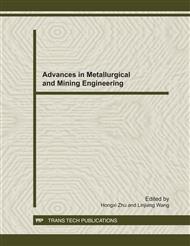[1]
Iryo T., Rowe, R. K.. On the hydraulic behavior of unsaturated nonwoven geotextiles. Geotextiles and Geomembranes, Vol.21 (2003), p.381.
DOI: 10.1016/s0266-1144(03)00046-3
Google Scholar
[2]
Zornberg J. G., Bouazza A., McCartney J. S. Geosynthetic capillary barriers: principles and applications. Proceedings 1st African Regional Geosynthetics Conference, , (2009)
Google Scholar
[3]
Fourie A. B., Bouazza A., Lupo J., Abrão P. Improving the performance of mining infrastructure through the judicious use of geosynthetics. 9th International Conference on Geosynthetics, (2010).
Google Scholar
[4]
Fu Haifeng, Yan Shuwang, Shu Xiaowu. Application and analysis of reinforcement and grouting combined treating soft foundation widening project. Rock and Soil Mechanics, Vol 28(2007), p.197.
Google Scholar
[5]
Zhu Xiang, Huang Xiaoming. Laboratory simulating test and field settlement observation of reinforced embankment. Chinese Journal of Geotechnical Engineering Vol 24 (2002), p.386.
Google Scholar
[6]
Smith M. E.. Mining and geosynthetics: emerging technologies, growing market. Proceedings 1st Pan American Geosynthetics Conferences (2008).
Google Scholar
[7]
Wei Zuoan, Li S.H., Liu Xiaoyu, Zhao Yin. The reinforcement terraced fields method. Chinese patent (No. 200610075635.3) (2006).
Google Scholar
[8]
Wei Zuoan, Yin Guangzhi, Li Guangzhi, Wang J. G., Wan Ling, Shen Louyan. Reinforced terraced fields method for fine tailings disposal. Mineral Engineering Vol 22 (2008),p.1053
DOI: 10.1016/j.mineng.2009.03.014
Google Scholar
[9]
Tailings storage facility design references writing group, Tailings storage facility design references. Beijing: Metallurgical Industry Press(1980)
Google Scholar
[10]
Board of Editors of "Introduction to Chinese non-ferrous metals tailings storage facility", Introduction to Chinese non-ferrous metals tailings storage facility . China National Nonferrous Metals Industry Corporation(1992).
Google Scholar
[11]
Lo S. C. R., Xu D. W.. A strain based design method for the collapse limit state of reinforced soil walls and slopes. Canadian Geotechnical Journal Vol 29(1992), p.832.
DOI: 10.1139/t92-090
Google Scholar
[12]
Nouri H, Fakher A., Jones C. J. F. P.,. Development of horizontal slice method for seismic stability analysis of reinforced slopes and walls. Geotextiles and Geomembranes, Vol. 24 (2006), p.175.
DOI: 10.1016/j.geotexmem.2005.11.004
Google Scholar
[13]
Shahgholi M., Fakher A., Jones C. J. F. P.. Horizontal slice method of analysis. Geotechnique Vol 51(2001), p.881 Chen Chang-fu, Yang Yu. Horizontal slice method of slope stability analysis based on evolutionary algorithm. Journal of Hunan University: natural Sciences Vol 31 (2004) ,p.72.
DOI: 10.1680/geot.2001.51.10.881
Google Scholar
[14]
Wang Zhi-bin, Li Liang, Yang Xiao-li, et al. Application of horizontal slice method in stability analysis of high fill embankments at slope. China Journal of Highway and Transport Vol 20(2007),p.29.
Google Scholar
[15]
Yin Guangzhi, Wei Zuoan, Wang J. G., Wan ling, Shen Louyan, 2008. Interaction characteristics of geosynthetics with fine tailings in pullout test [J]. Geosynthetics International Vol 15(2008), p.428.
DOI: 10.1680/gein.2008.15.6.428
Google Scholar


